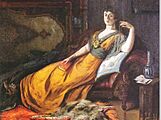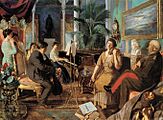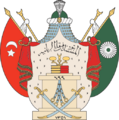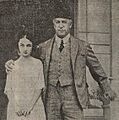Abdülmecid II facts for kids
Quick facts for kids Abdulmejid II |
|||||
|---|---|---|---|---|---|
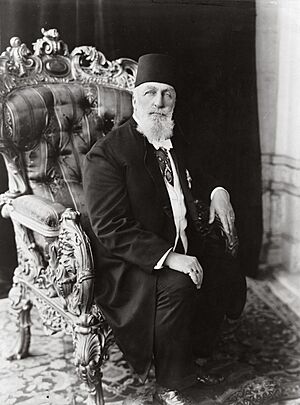
Official portrait of Caliph Abdulmejid II
|
|||||
| Ottoman caliph (Halîfe-i Müslimîn) |
|||||
| Tenure | 19 November 1922 – 3 March 1924 | ||||
| Predecessor | Mehmed VI | ||||
| Successor | Caliphate abolished | ||||
| Head of the Osmanoğlu family | |||||
| Reign | 16 May 1926 – 23 August 1944 | ||||
| Predecessor | Mehmed VI | ||||
| Successor | Ahmed Nihad | ||||
| Born | 29/30 May 1868 Beşiktaş, Istanbul, Ottoman Empire |
||||
| Died | 23 August 1944 (aged 76) Paris, France |
||||
| Burial | Al-Baqi', Medina, Saudi Arabia | ||||
| Consorts |
Şehsuvar Kadın
(m. 1896)Hayrünnisa Kadın
(m. 1902; died 1936)Mihrimah Bihruz Kadın
(m. 1912)Atiye Mehisti Kadın
(m. 1912) |
||||
| Issue |
|
||||
|
|||||
| Dynasty | Ottoman | ||||
| Father | Abdulaziz | ||||
| Mother | Hayranidil Kadın | ||||
| Religion | Sunni Islam | ||||
Abdülmecid II (born May 29, 1868 – died August 23, 1944) was the last Ottoman caliph. A caliph was seen as the leader of all Muslims. He was also the head of the Osmanoğlu family from 1926 to 1944. Unlike earlier caliphs, he used the title Caliph of the Muslims.
He was also a talented artist and loved art, especially literature, painting, and music. After the Ottoman caliphate ended, he was briefly followed by Hussein bin Ali in the Arab world.
Abdülmecid II passed away in Paris in 1944. He was buried in Medina, a holy city.
Contents
Life Story
Growing Up
Abdülmecid was born on May 30, 1868, in Dolmabahçe Palace in Istanbul. His father was Sultan Abdulaziz. He was educated at home.
Following Ottoman traditions, Abdülmecid stayed mostly within the palace until he was 40. In 1918, his cousin Mehmed VI became Sultan, and Abdülmecid was named the Crown Prince. He loved literature and started a group in 1920 to share the works of author Pierre Loti. He was also very interested in painting and created many artworks himself. He tried to bring realist art to the Ottoman Empire. He was also a composer and played the piano.
Becoming Caliph
When his cousin, the Sultan, was removed from power on November 1, 1922, the Ottoman Sultanate was ended. However, on November 19, 1922, Abdülmecid was chosen as the new Caliph by the Turkish National Assembly in Ankara. He moved to Istanbul on November 24, 1922.
Not all Muslims agreed with his choice as caliph. Some people, especially in Palestine, preferred Hussein bin Ali. But most Muslims eventually recognized Abdülmecid as their leader.
Abdülmecid faced some challenges. He was criticized for living in the Yıldız Palace in Istanbul. He was also unhappy when some government duties were moved from Istanbul to Ankara.
On March 3, 1924, the Ottoman Caliphate was officially ended. The Ottoman royal family was removed from power and had to leave Turkey.
Life in Exile
The caliph was seen as the top religious leader for Muslims worldwide. In 1924, the Turkish government decided that the caliphate was no longer needed. A law was passed to end it and to send all members of the Ottoman royal family out of Turkey.
Abdülmecid and his family were sad about this decision. To avoid any public unrest, they quietly left Dolmabahçe Palace by car early the next morning. They traveled to Çatalca and then took the Simplon Express train out of Turkey.
He first went to Switzerland. However, he was not welcomed with any special ceremony. He also faced money problems. In Switzerland, he expressed his sadness about the caliphate being abolished. He believed it would cause problems in the Islamic world. But the Turkish government pressured Switzerland, so he could not give such speeches anymore. In October 1924, he moved to Nice, France.
Abdülmecid lived a quiet life in Nice, France. His daughter Dürrüşehvar Sultan and his niece Nilüfer Hanım Sultan married sons of the Nizam of Hyderabad, who was one of the richest people in the world. This helped improve his financial situation. Since he didn't get the support he hoped for to bring back the caliphate, he focused more on his faith, painting, and music.
Later, Abdülmecid moved to Paris. He often attended Friday prayers at the Grand Mosque of Paris. He wrote a 12-volume book of his memories, which his daughter Dürrüşehvar Sultan kept safe.
On August 23, 1944, Abdülmecid II died in his home in Paris from a heart attack. This happened during the Liberation of Paris from German occupation. His daughter tried to have him buried in Turkey, but the Turkish government did not allow it. His body was kept at the Grand Mosque of Paris for ten years. Finally, he was buried in Medina.
As an Artist
Abdülmecid was given the title of General in the Ottoman Army, but he was more interested in art. He was the Chairman of the Ottoman Artists' Society. He was friends with Western painters like Fausto Zonaro, who was important in art in the Ottoman Empire.
He is considered one of the most important painters of late Ottoman art. His paintings show the influence of Western Europe in his circle. For example, he painted his wife, Şehsuvar Hanım, reading Goethe's novel Faust. These paintings were shown at an exhibition in Vienna in 1918. His self-portrait can be seen at Istanbul Modern.
Abdülmecid also loved collecting butterflies for the last 20 years of his life.
Famous Paintings
-
Painting of Abdülhak Hamit Tarhan, with the text in Ottoman Turkish saying, "made with the heart".
Family Life
Abdülmecid II had four wives:
- Şehsuvar Kadın (1881–1945). They married in 1896 and had a son, Şehzade Ömer Faruk.
- Hayrünnisa Kadın (1876-1936). They married in 1902. She was very educated and a talented cello player.
- Mihrimah Bihruz Kadın (1893–1955). They married in 1912.
- Atiye Mehisti Kadın (1892–1964). They married in 1912 and had a daughter, Dürrüşehvar Sultan.
Children
Abdülmecid II had a son and a daughter:
- Şehzade Ömer Faruk (1898 - 1969) - with Şehsuvar Kadın. He married two of his cousins and had three daughters.
- Hatice Hayriye Ayşe Dürrüşehvar Sultan (1914 - 2006) - with Mehisti Kadın. She married an Indian prince and had two sons.
Honours and Arms
Ottoman Honours
- Order of House of Osman, Jeweled
- Order of Glory, Jeweled
- Imtiyaz Medal, Jeweled
- Order of Osmanieh, Jeweled
- Order of the Medjidie, Jeweled
- Iftikhar Sanayi Medal
- Imtiyaz War Medal in Gold
- Outstanding Navy Medal in Gold
Foreign Honours
 Austria-Hungary: Grand-Cross Order of Leopold, June 6, 1918
Austria-Hungary: Grand-Cross Order of Leopold, June 6, 1918 Persia: Order of the Crown, 2nd Class, August 23, 1919
Persia: Order of the Crown, 2nd Class, August 23, 1919
Arms
Images for kids
-
Abdulmejid II with his daughter Dürrüşehvar and fourth wife Mehisti Hanım
-
Princess Dürrüşehvar Sultan, Princess of Berar; Caliph Abdulmejid II of the Ottoman dynasty, and Nawab Azam Jah, Prince of Berar, 1931
-
Portrait of Abdulmejid II in Topkapı Palace Museum
See Also


